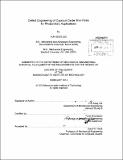| dc.contributor.advisor | Tonio Buonassisi. | en_US |
| dc.contributor.author | Lee, Yun Seog | en_US |
| dc.contributor.other | Massachusetts Institute of Technology. Department of Mechanical Engineering. | en_US |
| dc.date.accessioned | 2013-06-17T19:53:21Z | |
| dc.date.available | 2013-06-17T19:53:21Z | |
| dc.date.copyright | 2013 | en_US |
| dc.date.issued | 2013 | en_US |
| dc.identifier.uri | http://hdl.handle.net/1721.1/79287 | |
| dc.description | Thesis (Ph. D.)--Massachusetts Institute of Technology, Dept. of Mechanical Engineering, 2013. | en_US |
| dc.description | Cataloged from PDF version of thesis. | en_US |
| dc.description | Includes bibliographical references (p. 111-119). | en_US |
| dc.description.abstract | Thin-film solar cells are promising for renewable-energy applications due to their low material usage and inexpensive manufacturing potential, making them compatible with terawatts-level deployment. Cuprous oxide (Cu₂O) is an earthabundant semiconductor with desirable properties for light-absorbing layers. However, power conversion efficiencies of solar cells comprising this absorber material remain significantly below the theoretical limit. In this thesis, I utilize novel materials and device geometries to engineer defects in Cu₂O thin-films and overcome the low power-conversion-efficiency of Cu 20-based solar cells. First, nitrogen doping is proposed as an effective p-type doping method to control optical and electrical properties of Cu₂O thin-films. The film's p-type conductivity is elucidated by temperature-dependent Hall effect measurements and a compensated semiconductor model. Secondly, an atomic-layer-deposited amorphous zinc-tin-oxide buffer layer is developed to mitigate non-ideal band alignment and interfacial defect-assisted recombination in Cu₂O - zinc oxide (ZnO) heterojunction devices. Reduced interfacial recombination is demonstrated by incorporating a 5-nm-thick buffer layer in the device. Finally, I propose a spatially controlled vertical ZnO nanowire array to overcome the short minority carrier diffusion length in Cu₂O. A scalable fabrication process is developed using colloidal lithography and hydrothermal growth of ZnO nanowires. Optical simulations are also conducted to investigate the effect of nanostructured device geometry on light-absorption properties. | en_US |
| dc.description.statementofresponsibility | by Yun Seog Lee. | en_US |
| dc.format.extent | 119 p. | en_US |
| dc.language.iso | eng | en_US |
| dc.publisher | Massachusetts Institute of Technology | en_US |
| dc.rights | M.I.T. theses are protected by
copyright. They may be viewed from this source for any purpose, but
reproduction or distribution in any format is prohibited without written
permission. See provided URL for inquiries about permission. | en_US |
| dc.rights.uri | http://dspace.mit.edu/handle/1721.1/7582 | en_US |
| dc.subject | Mechanical Engineering. | en_US |
| dc.title | Defect engineering of cuprous oxide thin-films for photovoltaic applications | en_US |
| dc.title.alternative | Defect engineering of Cu₂O thin-films for photovoltaic applications | en_US |
| dc.type | Thesis | en_US |
| dc.description.degree | Ph.D. | en_US |
| dc.contributor.department | Massachusetts Institute of Technology. Department of Mechanical Engineering | |
| dc.identifier.oclc | 846911643 | en_US |
